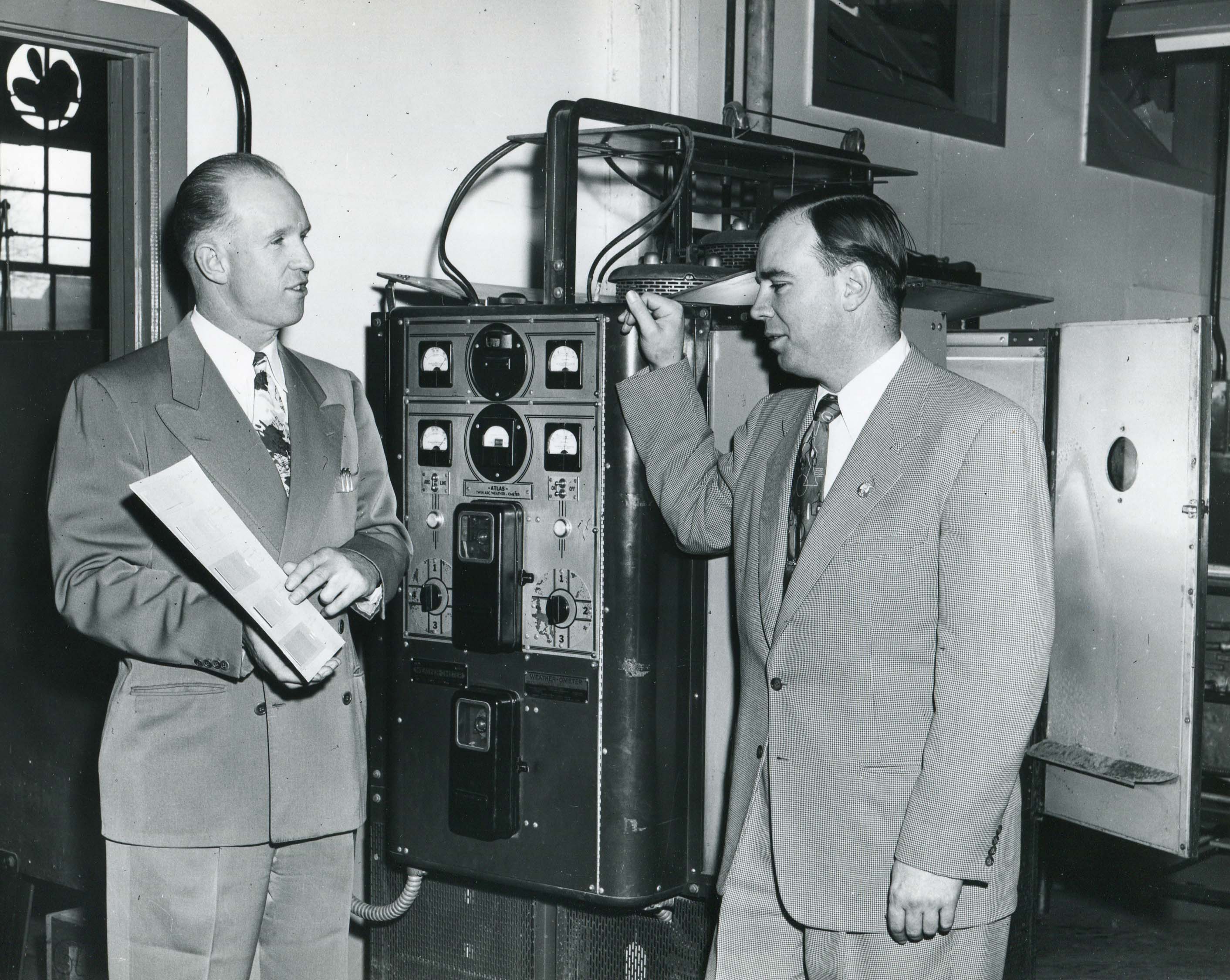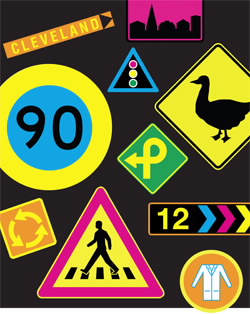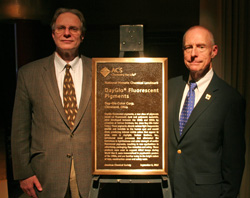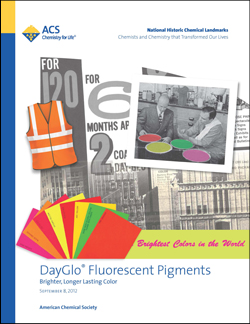DayGlo Fluorescent Pigments
Designated September 8, 2012, at Day-Glo Color Corp. in Cleveland, Ohio.
DayGlo fluorescent pigments, a new class of pigments based on fluorescent dyes and polymeric materials, were developed between the 1930s and 1950s by scientists at Switzer Brothers, Inc. (now Day-Glo Color Corp.). These pigments absorb various light frequencies (visible and invisible to the human eye) and reemit them, producing intense visible colors that appear to glow, even in daylight. Switzer Brothers, Inc., introduced novel processes that eliminated the limitations in light fastness and color strength of earlier fluorescent pigments, resulting in new applications in advertising, packaging, flaw detection and safety.
Contents
The Switzer Brothers
Brothers Robert (Bob) and Joseph (Joe) Switzer were teenagers in Berkeley, California, in the 1930s. The Great Depression was raging, and life was difficult for the Switzer family. Their father, Emmet, and mother, Maude, operated a pharmacy with the help of their four children.
During the summer of 1933, Bob, a pre-med student at the University of California at Berkeley, found a summer job in an H. J. Heinz Company quality control laboratory to help support the family. One of his duties was to take samples from incoming shipments. A serious accident occurred while unloading a freight car, and Bob was found unconscious lying beside the train tracks. His skull fractured in the accident, Bob awoke in the hospital with brain damage, a partially severed optic nerve, double vision, and extensive loss of memory.
Bob spent the next few months recuperating at home. For his eyesight to recover, doctors recommended that he avoid bright light. During this time, Bob and Joe developed a curiosity about fluorescence, which they investigated using a portable black light amongst the materials stored in their family’s pharmacy.
Black lights emit ultraviolet (UV) light, an invisible class of electromagnetic radiation with a higher frequency than visible light but lower than X-rays. Fluorescent materials absorb the UV light and reemit it as visible light. In darkness, UV fluorescent objects appear to glow when exposed to black light.
The brothers found several naturally-fluorescing organic compounds and realized that they could be used to enhance Joe’s amateur magic shows. They went about experimenting with ways to turn the fluorescing compounds into paint and had some early success combining the materials with shellac. Joe used their experimental paint to design costumes that glowed onstage under black light. In 1934, Joe performed his “Magic Balinese Illusion,” which uses fluorescent costumes to make a dancer appear and contort, earning a prize for best illusion during a magicians’ convention in Oakland.
Following the success of their early onstage illusions, the brothers soon realized the potential for development of fluorescents in advertising and merchandise display. The first written record that predicts the development of fluorescent technology, written by Bob in 1934, describes Joe as having “conceived the idea of projecting ultra violet light ... upon all displayable articles which fluoresce (or are treated with fluorescent materials) to produce a beautiful and noble method of displaying merchandise.”
Ultraviolet Fluorescents
In 1934 the Switzers established their first company, the Fluor-S-Art Co., and partnered with San Francisco artist Delmar Gray to produce fluorescent displays for commercial advertising. They also contributed advances in black lighting for such displays.
An early display designed for a San Francisco department store failed, however, when street lighting interfered with the black light effects. Because fluorescent paint relied on ultraviolet light, it could only be successful where conditions allowed for complete control of lighting conditions. Light pollution, deficiencies in black light sources, and exposure to sunlight all contributed to the degradation of fluorescent displays.
Later the same year, an indoor department store display became a popular success, using fluorescent paint and flowing liquids to create a Christmas scene. The following year, Joe met with representatives from Continental Lithograph, an advertising subsidiary of Warner Bros. Pictures located in Cleveland, Ohio. The company specialized in producing posters for the motion picture industry. Joe sold Continental on the idea of producing fluorescent posters illuminated in theater lobbies by black light. To demonstrate the fluorescent effects, the Switzer brothers, along with artist Gray, designed a display that filled the monumental lobby of Cleveland’s Hippodrome movie house. The display was a success, and Continental was sold on the power of fluorescent displays for Warner Bros. theaters across the country.
While early posters were painted by hand, the volume of prints purchased by Continental required the development of fluorescent lithography and silk-screen inks. It was at this time that Joe became involved in the development of printing inks. With the help of Dick Forbes of Forbes Ink Co., Joe made hundreds of test batches and ultimately developed a new manufacturing method for fluorescent ink. At the time, fluorescent paint was prepared using white shellac colored with fluorescent dyes and dissolved in alcohol—a product not suitable for mixing with oily printing ink varnishes. Joe developed a process that used water to absorb the alcohol, which then could be easily separated from the oil contents. This process could be used to produce fluorescent inks that worked well on presses.
Daylight Fluorescents and WWII
Despite these early successes, the brothers saw that they would need to develop new products that overcame their limitations. Beginning in the early 1940s, the Switzers began making improvements in a class of pigments they called “daylight fluorescents,” which not only fluoresce under black light conditions, but also in daylight. Simply described, daylight fluorescents convert energy from the ultraviolet spectrum and transform them into longer wavelengths that are visible to the human eye. An object coated with a specific daylight fluorescent pigment reflects its visible color and absorbs and transforms UV wavelengths into this color. This creates the visual effect of super brilliance, and is comparatively brighter than standard color. These products became known as DayGlo fluorescents.
Fluorescent products of both kinds found use by the military during World War II for a variety of visual signaling purposes. UV fluorescing materials allowed Allies to use aircraft carriers at night, an advantage over the Japanese military. DayGlo fluorescent fabric panels were used by troops in North Africa to identify themselves as friendly to Allied aircraft. After the War, U.S. aircraft were painted with the signature DayGlo “Blaze Orange” color to increase their visibility and avoid mid-air collisions.
The Switzers also introduced black light fluorescent penetrants that were found to be useful for the war effort and are still used today. The penetrants are applied to the metal parts, settle into unseen cracks and other flaws, and show these defects under black light. Two systems—Magnaglo® and Zyglo®—utilized fluorescence in flaw detection. Zyglo, a process that did not rely on magnetic principles and was therefore effective on aluminum (a key component of airplane parts), was particularly important and soon was required by the U.S. Air Force for use on a variety of critical parts to ensure part quality.

Joe Switzer, 1936 patent application
Commercial Products
In 1946, the Switzer Brothers ended their agreements with Continental and founded Switzer Brothers, Inc. (now Day-Glo Color Corp.), in Cleveland. Flaw detection products continued to be a large portion of their product lines, but they also expanded their research to improve daylight fluorescent pigments for commercial uses.
After a series of developments in the field, a milestone came in 1957 with the patent for a new process for producing daylight fluorescent pigments. Combining the fluorescent dyes with a new class of polymers and then milling the composition to an appropriate particle size produced material that behaved like traditional organic and inorganic pigments in printing techniques. These new pigments could be used as traditional paint and inks and had sufficient light stability to be used outdoors.
Growth in the use of fluorescent pigments for marketing and packaging took off following the War. The company made inroads by marketing their products—DayGlo brand silk-screen inks, paint, and papers—to advertisers. Their first big break in packaging came in 1959 in an application that’s still known by its DayGlo colors today: Tide® detergent. Fluorescent boxes of Tide were soon on display on grocery shelves nationwide, and fluorescent colors began to appear on an increasing number of consumer products.
Safety applications became another major market for fluorescent colors: Traffic cones, safety vests, and many other products for which enhanced visibility is of great importance are all colored by fluorescent pigments. Today, firefighters, construction workers, crossing guards, and many others are identified by the fluorescent colors emblazoned on their uniforms.
By the 1960s, fluorescent colors had become ubiquitous with the emergence of psychedelic posters, clothing, toys, and accessories of the 1960s. From hippies to Pop artists, a new fluorescent identity had emerged in DayGlo’s fluorescent palette: Corona Magenta, Aurora Pink, Rocket Red, Fire Orange, Blaze Orange, Arc Yellow, Saturn Yellow, and Signal Green.

“The fluorescent color was a highly exciting and new advertising medium. People were startled by it.”
Gordon Russell, former Day-Glo Color Corp. Vice President of Marketing
Landmark Designation and Acknowledgments
Landmark Designation
The American Chemical Society designated the development of DayGlo fluorescent pigments as a National Historic Chemical Landmark at Day-Glo Color Corp. in Cleveland, Ohio, on September 8, 2012. The text of the plaque commemorating the development reads:
DayGlo fluorescent pigments, a new class of pigments based on fluorescent dyes and polymeric materials, were developed between the 1930s and 1950s by scientists at Switzer Brothers, Inc. (now Day-Glo Color Corp.). These pigments absorb various light frequencies (visible and invisible to the human eye) and reemit them, producing intense visible colors that appear to glow, even in daylight. Switzer Brothers, Inc., introduced novel processes that eliminated the limitations in light fastness and color strength of earlier fluorescent pigments, resulting in new applications in advertising, packaging, flaw detection and safety. These products were used to support Allied troops during World War II, were immortalized in psychedelic posters of the 1960s, and are familiar today in the bright colors of toys, construction cones and safety vests.
Acknowledgments
Adapted for the internet from “DayGlo Fluorescent Pigments,” produced by the National Historic Chemical Landmarks program of the American Chemical Society in 2012.
DayGlo, Corona Magenta, Aurora Pink, Rocket Red, Fire Orange, Blaze Orange, Arc Yellow, Saturn Yellow, and Signal Green are registered trademarks of Day-Glo Color Corp., an RPM International Inc. company.
Magnaglo and Zyglo are registered trademarks of Magnaflux, a division of Illinois Tool Works, Inc.
Tide is a registered trademark of The Proctor & Gamble Company.
Learn more: About the Landmarks Program
Take action: Nominate a Landmark and Contact the NHCL Coordinator



